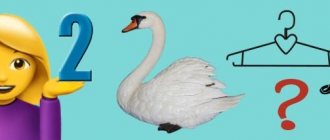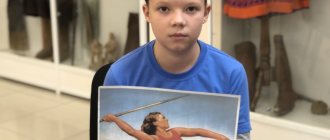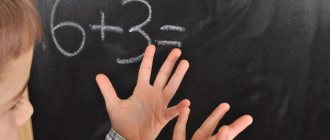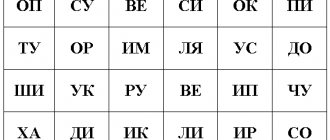Don't expect school to teach your child everything. Just as a mother teaches a baby the first steps, the basics of reading should be laid in the first years of life. You can’t start learning the alphabet from scratch - instill a craving for literature in your child in advance, before he goes to first grade.
Children are proud of their ability to read
Start with speech development
Before learning to read, a child must learn to speak. And the correctness of speech development directly depends on their environment. The more intelligent the parents, the more attention they pay to the younger generation, the easier it is for the child to develop.
From the first days you need to work with your baby on speech development
Starting the first communications with adults through hooting, the baby gradually tries to imitate the speech sounds that he hears every day. And if at first these are just individual syllables, then already from the age of 2 years of normal development the child can operate with simple sentences.
Further - more, the baby moves on to word forms. And the more actively the parents communicate with the child, the more talkative he will be (in a good way). The main help in the development of a child’s speech will be reading, i.e. books that adults will read aloud to their children.
Develop your baby's interest in reading
Naturally, a small child cannot read on his own. But you can accustom him to communicate with literature from the first years of his life. It is children's books that form the correct speech development of the baby. The more often a child sees a book in the hands of his parents, the more confidence he develops in it, and the faster over time the desire to learn to read independently appears.
Interest in reading develops in a playful way
Reading should be turned into a kind of ritual - fairy tales, nursery rhymes, lullabies are best perceived before bed. The clearer and more correct the adult’s pronunciation during reading, with emotional connotation, the more memorable the phrases the child will hear will be.
And the clearer the baby’s visual images will appear. And this will further help in learning to read. After all, the better a child thinks in images, the faster and easier he learns.
About the benefits of family reading
To develop children's skill, they should read fairy tales aloud from preschool age. The child must develop not just an interest in literature - the book must become a symbol of psychological “pleasure”.
Family reading develops children's interest in it
And in the future, even magazines and books standing on shelves (and not in the hands of parents) will be associated with positive emotions and attract the child’s attention. In other words, reading books to your child instills a love of literature for life, giving impetus to the fastest learning of independent reading.
In addition, reading to children promotes their spiritual unity with their parents, bringing joy to everyone. And the child develops a feeling of family comfort, which he associates with books. In a family where there is a cult of books, children quickly develop a desire to read.
Read with your children
The best way to prepare your child for independent reading is to read a book while sitting next to your baby. He should see the pages of the book on which the text is written. This will first allow you to visually get used to the letters that involve you in the world of the sacraments.
A child’s first books should be of high quality and bright
It’s not for nothing that the first children’s books are rich in colorful illustrations. With their help, you can perceive what you hear in images drawn in the pictures. And when the child goes to first grade and begins to put letters into words, familiar phrases will already be perceived figuratively, which will make it faster and easier to learn to read.
While reading a fairy tale or nursery rhyme, try to move your child’s finger over the letters so that the baby can see which word you are reading. Visual memory will help with proper learning in the future.
Texts for children 6-7 years old
If you are preparing reading texts for children 6-7 years old, you can print out entire paragraphs. For work, choose excerpts from fairy tales and short stories. Large works can be worked on in 2-3 lessons. Don't forget about short stories from the alphabet or primer.
General recommendations
- Work through the sentences in a chain, try to involve each student.
- After reading a short passage for the first time, discuss the content. If you find any misunderstandings, read the passage again.
- If we read syllables individually, different texts for reading to children 7 years old need to be printed on separate sheets.
Texts with tails:
Tasks
After familiarizing yourself with the passage, offer preschoolers the following entertaining activities aimed at developing the ability to accurately understand information and interpret it.
- Brief retelling.
- Answers to questions about the content.
- Choose synonyms.
- First read the sentence, then say it differently.
Texts with holes:
Working with text in preparation for school should be used in speech therapy and developmental classes on various topics. Incorporate reading into the daily life of your future first-grader. Let him read the announcements at the entrance, signs and advertisements in stores, and a bedtime story with his parents in turn. In this case, automating the formation of syllables, words and understanding the information read will become a simple task for a preschooler.
How to properly teach a child to read?
The sooner a child is ready to perceive, the better - when he goes to 1st grade, he should master the basics of reading. Even if the baby goes to kindergarten, where he is taught using a special method, parents should also set aside time for joint activities.
How to approach the process itself correctly so that learning is easy? You cannot teach children by force - everything should happen in a playful way. When choosing a technique, you should also take into account the age at which training began.
It is necessary to develop the correct pronunciation of sounds
But in any case, you shouldn’t learn just letters - you should start with phonetic sounds. It will be easier for the child to associate the written symbol with the sound that he is accustomed to hearing.
Learning is easier if each lesson learned is repeated many times. From the moment you learn sounds to reading syllables, monitor your baby’s clear pronunciation of speech.
Stages of training
It is impossible to teach a child to read quickly without a special technique, as well as without an appropriate (consistent) systematics.
- Choose the right manual to teach your children. Recently, there are several options for primers on sale. Choose one that will be interesting to your child (you can go shopping with him). Even if there are fewer pictures there, it should be based on speech therapy techniques (for example, N.S. Zhukova’s alphabet).
Magnetic alphabet by N.S. Zhukova - When the manual is purchased, begin step-by-step learning of sounds:
– first learn all the vowels;
– then move on to mastering voiced hard consonants, paying attention to correct pronunciation;
- then comes the turn of dull sounds;
– leave the sizzling ones for last.
- Repeat each sound you learn before starting to learn the next one. “Repetition is the mother of learning” - this phrase should become the guiding thread of the entire learning process.
- In parallel with studying sounds, begin to form syllables (and the very first one can be “ma”, which will be close and sincere to the child). Read the syllable together with your baby, as if singing it. The child should have the feeling that the consonant sound seems to be striving for a vowel. This will help you pronounce sounds in pairs.
- Do not try to immediately form the learned syllables into words. Let the child first understand the principle of combining vowels and consonants in pairs. Consolidate your knowledge on simple syllables, gradually moving on to difficult to pronounce ones.
- Having taught your child to form syllables where the consonant sound comes first, proceed to a more complex structure where the vowel comes first (“om”, “ab”, etc.).
- Having become comfortable with individual syllables, transfer children to reading simple words. Start with those that consist of 2 syllables, then 3-syllables. But the first words that a child reads should be familiar to him and associated with understandable images.
How to work with texts
Reading poems and short stories for a preschooler is a new type of work. The difficulty in completing the reading task is that the kindergartener does not always understand the meaning of the passage. To avoid this, you need to approach the choice of material and methods of its processing correctly. Organize your learning process as follows:
- Select handouts based on the student's age. For children 4-5 years old, cards of 1-3 sentences, for older preschoolers - 4-5 sentences.
- Pay attention to the number of words in the sentences. There should be few of them. Simple reading texts for preschoolers are easier to digest, but you cannot stay at the easy level for long.
- Proceed to working with text cards after automating syllabic reading.
- Read in sequence in a group or with adults when working individually.
- Don't rush your child. At the learning stage, reading comprehension is important, not reading speed and the amount of time spent.
Correct pronunciation is the key to quick learning
Do you know how to teach a child to read quickly? Let him sing every sound and syllable he learns, but do it clearly. When you move on to pronouncing words, at first the syllables should be sung separately, with each subsequent time shortening the gaps between them. And ultimately, the entire word must be sung in one breath.
Singing sounds promotes speech development
But so that reading in children is not associated only with singing, the consolidation of the material should take place in normal pronunciation, with clear pronunciation of sounds. At the same time, when you move on to reading sentences, teach your child to take the correct pauses before punctuation marks.
Important stage: reading syllables
Some programs, as well as unsystematic independent studies, do not allow you to work on one of the most significant stages - syllabic. In the future, this leads to the fact that it is difficult for the student to master phrase reproduction. He fails to smoothly transition to it after the syllable stage, since the speed and quality of reading comprehension suffers.
Therefore, after studying the alphabet and mastering letter-by-letter reproduction, it is necessary to study syllables, starting with simple ones and gradually moving to complex ones. This is the approach used in the phonic method, which is why it is best suited for teaching children to read.
When is the best time to start training?
At what age should children be able to read is a question many parents ask. This, first of all, depends on how psychologically prepared the child is for learning. But it should definitely be said that school should not begin immediately before school, when children are going to 1st grade.
Children can begin to be taught at the age of 3 years, if the child himself expresses a desire to do so. But you shouldn’t force them to sit down with books - this may discourage them from further learning.
The most optimal receptive age at which to prepare for 1st grade is 5 years. And in parallel with reading, children should be taught writing (for now only in printed letters), which will help them consolidate their reading skills.
How do you know when your child is ready?
To understand how to teach a child to read, you must first decide whether the child is ready for such learning. To do this, first test the degree of development of the child.
Make sure your child is ready to learn
- If children are already speaking in sentences, they are ready for the learning process.
- The development of phonetic hearing is an important factor. Correct perception of sounds, their differences and the ability to operate with them will help you quickly and easily teach your baby.
- A child who speaks incorrectly is not able to quickly learn to read, because... poorly perceives those phonetic sounds that he himself pronounces.
- If children do not have developed imaginative thinking, it will be difficult to teach them to read quickly - the process will turn out to be purely mechanical. And in the future, the procedure itself will be too tedious and uninteresting for the baby.
- The child must have the basics of logical reasoning, which allows him to compare facts in the learning process. Teaching reading by matching pictures and words
Basic methods – which one to choose?
When choosing a program, it is important to pay attention to many criteria - find out what stages it includes, in what form the classes are conducted, whether they will be interesting, whether it will be easy to learn to read. It is worth remembering that the goal of this or that method is not only to teach literacy, but also to interest, to awaken the desire to get acquainted first with small texts, and then with books. To do this, classes must be taught by professional teachers according to a program that takes into account the age characteristics of students.
Preschoolers from 5 years of age and younger schoolchildren will benefit from the reading teaching method from the AMAkids Academy for the Development of Intelligence. Its key feature is the game format, as well as the principle of a gradual transition from simple to complex topics. Before moving on to a new stage, students’ knowledge is checked and, if necessary, further consolidated. This way you can more effectively master all the material and learn to read fluently. Sign up for courses from AMAkids and start teaching your child to read and write now.
Training using the Nikitin method
Classics of Russian education, the Nikitins' spouses completely moved away from traditional teaching principles, putting forward their own instead. They believe that children should be given complete creative freedom in the classroom. Only then will they become interested in learning.
There is no need to limit the independence of children - they must do all the work themselves. The third rule is a combination of mental exercises and physical exercises (i.e., learning in a playful way).
Involve your child in joint activities - for example, you can prepare study guides together. And then the baby will perceive the material easier and faster. But the main incentive for successful learning is praise for even the most insignificant victory. And you should never focus on mistakes.
Educational toys of the Nikitins
Here are the basic principles by which the Nikitins taught their children (and they can be applied to children 3 years old, 5, and 7):
- You cannot impose a specific learning program on a child - he himself chooses in the form of which game he is more interested in learning letters.
- There is no need to explain the course of the game to your child. Make your studies seem like a fairy tale, where each participant has their own role.
- In the first stages of play-learning, adults are active participants. In the future, when the child gets used to it, he will be able to continue classes on his own.
- A learning child should always be unobtrusively given tasks that will become more difficult at each new stage.
- Don’t dare tell your child – teach him to think for himself.
- If it is difficult for your child to cope with a new task, do not force him - take a step back and repeat what you have learned.
- If you notice that your child has lost interest in the game, or has reached the limit of his capabilities (temporary), stop training for a while. Get back to studying when your baby asks. And he will definitely do this, because... all children love to play.
The child is growing up and yesterday’s baby is already interested in reading? Or not interested, but you feel it’s time? Modern bookstores have a huge variety of aids for teaching reading. This is, of course, good - there is plenty to choose from. But there are also disadvantages to this - it’s easy to get confused and miss out on truly valuable publications in the diversity of the book world. This collection contains the best textbooks for teaching reading to children 4-6 years old. Choose according to your taste. The main thing is that the lesson time is appropriate to the child’s age and takes place in a relaxed atmosphere. By the way, it is also better to choose books for first reading from proven ones. Let your child's learning be easy and joyful!
Daria Gerasimova “The ABC of Transformations”
The alphabet in this book is not classical, but is presented in a light poetic form. Each letter is described by some object starting with that letter. Both the verses themselves and the letters are easy to remember. Cheerful illustrations harmoniously complement the text, and the book itself exudes coziness and a certain handicraft. The book has an envelope, and in it are coloring cards. The cover was also creatively done: the letter A has hair made of threads, because it is known that fine motor skills and tactile activities help the brain with the development and acquisition of speech. So this publication can be considered not only fun, but also useful. In this way, you can start learning letters from the age of two. A4 format, high quality printing. Thick cover, 64 pages.
Nadezhda Zhukova “Primer. Tutorial"
This primer has already become a classic. There are no entertainment elements in it, only educational techniques that are designed to help you master reading quite quickly and easily. The methodology is based on traditional teaching of reading with the original approach of a speech therapist. Its essence is that it is explained to the child that one sound seems to “run” to the next, combining into words. As a result, there is an awareness of the letter combination as a whole word, expressed graphically. It is important that before you and your child begin to learn the alphabet, the baby is not familiar with the letters, otherwise confusion may arise, because words do not consist of letters, but sounds. You can start studying as early as 3–4 years old.
Zhutaute Lina “Tosya-Bosya plays with letters”
As the name suggests, Tosya-Bosya plays with letters rather than studying them. In essence, the book helps to consolidate in a playful way what has been previously learned. There are also tasks for very young children (from about 3.5 years old): tracing letters along dotted lines, looking for your name among the letters of the alphabet, coloring letters, making appliqués, connecting a letter with a corresponding object. There are also tasks for older children: anagrams, drawing more complex images, copywriting. Therefore, playing with this book can be extended over a long period of time, up to 6 years. Vivid illustrations, high-quality printing. Suitable not only for Toshi-Boshi fans.
Elena Uleva “Trainer. Issue 1. Reading short words"
After the child has learned all the letters, it is quite logical to try to combine them into words. Little by little - from syllables and short, simple words - the simulator tells you how to move on to reading more complex and longer words, and then sentences. After reading a word, the child is asked to complete an additional task, which is designed to motivate him to read in the future. With the advent of the realization that reading opens the door to a new world, the child can no longer be stopped, he wants to read more and more, and now he is already reading store signs and all the inscriptions that he encounters on his way. And there it’s not far from a volume of some great classic. Soft workbook, tasks are colorfully illustrated, 32 pages.
Yulia Pchelintseva “Slovolodochki. Mom, teach me to read! Author's reading course"
This author's technique helps to quickly teach a child to read correctly. The approach is traditional: the child learns sounds and letters, puts the letters into syllables, and the syllables, using special “boats,” are linked into words. The uniqueness of this technique is that the book can be used at any stage of learning to read: you can only know the letters, already be able to add syllables, or try to read the first words. This book is also good because it contains a lot of practical advice: where to start learning to read, at what age is it better to do it, what to do if the child does not listen to what they are trying to explain to him and where to gain patience for learning if he lacks.
Yulia Danilova “Super-effective reading simulator for little students”
Do you know who the bullies are? They are such funny characters and always a lot of fun to be with. They love to play pranks, scare each other and make up different stories. Buzayki will also teach your child to read. Not right away, of course, but gradually, by reading the simple exclamations of the characters in the book, you can really learn to read. The main thing is that the learning process will take place casually, in a relaxed atmosphere. The complexity of tasks goes from simple to complex. Funny unexpected tasks, naughty puzzles, bright illustrations and a simple plot will captivate your child. This is a truly effective simulator, but it requires the emotional involvement of an adult. Yulia Danilova is a teacher with extensive experience, the author of methods for teaching children. Check out her “A Primer for a Very Busy Mom.” 64 pages, softcover. The book is almost A4 in size.
Olesya Zhukova “Reading trainer”
A manual with tasks for developing reading skills. Large letters are accompanied by bright, clear pictures. Exercises are based on the principle “from simple to complex.” Words are divided into syllables, most tasks are based on mastering syllabic reading. A colorful training book not only teaches reading, but also develops thinking, attention, and memory. Large format manual, good quality paper, color illustrations. 32 pages, softcover. The author of the book is a specialist in child development, a teacher with extensive experience. If you like her reading simulator, pay attention to the author’s other manuals: “Speech therapy primer”, “Large recipes for a speech therapy primer”, “Neurologopedic recipes. We learn letters”, etc.
Evgenia Kats “Learning to read. Let's play with letters. For children from 6 years old. Federal State Educational Standard"
Zhenya Katz is known for her textbooks on mathematics (“Mousematics”) with non-trivial and varied exercises. So this book contains unusual tasks for learning to read: how many letters “K” are in these words; circle “P” in blue and “M” in red; which letter has changed, etc. The manual contains many games with letters and words. The tasks and puzzles are aimed not only at mastering reading, but also at selecting rhymes, counting, logic, and attention. Bright, simple illustrations help you better understand the material. The font is large, high-quality printing. 48 pages, softcover.
Uzorova O., Nefedova E. “350 best exercises for teaching reading”
The manual from well-known practicing teachers is built on the principle of “one day - one lesson”. First, the child masters letters, then simple syllables, and then short words and simple sentences. No more than seven minutes a day - you must agree, it is quite possible to find an opportunity for such short activities - and your child will learn to read. At the beginning of the book there is a note for parents. For example, there are important tips: do not overdo it when studying with your baby, so as not to discourage the desire to learn. And also repeat what you have covered during a walk, between times, before going to bed. 96 pages, softcover. A4 format.
Daria Sukhova “Global reading. Primer + set of cards. A manual with instructions for classes with children from 3 years old"
The primer contains syllabic tables, exercises for reading letters, and then simple syllables. Non-trivial tasks are also present: find a letter in a word, find a certain letter among other letters, etc. The primer comes with a set of cards printed on 26 sheets. The manual contains a QR code where you can find additional materials. The tasks are aimed not only at teaching reading, but also at developing memory, attention, and spatial thinking. 216 pages, hardcover. Large format. The author of the book is a teacher with twenty years of experience, including with dysgraphic children. Daria Sukhova has also published several manuals on reading and arithmetic.
Nikolay Zaitsev – teaching innovator
Traditional teaching based on the “phonemic-verbal” principle enslaves the freedom of speech of the child being taught and forms complexes in him, inhibiting his development - this is what teacher Nikolai Zaitsev believes.
He developed his own unique technique, more like a game than a lesson. Children move freely around the classroom (room). At the same time, they can jump, run, etc. You can master the educational material in any position - in motion or sitting, lying down. And this should start earlier - from about 3 years old.
Zaitsev cubes
All manuals are posted on walls, boards, cabinets, and tables. Usually this is a set of cardboard cubes. They are of different sizes and different colors. Some faces depict single letters, others – syllables (both simple and complex), and still others – consonants with a soft or hard sign.
Previously, the cubes can be in the form of blanks, which the teacher glues together with the children. In this case, special fillers should be placed inside:
- It is better to put sticks (wooden and plastic) into cubes with dull sounds;
- for ringing sounds, metal bottle caps are suitable;
- Bells will be hidden inside the cubes with vowel sounds.
Training using the Zaitsev method
Cubes should differ in size (both single and double). For soft warehouses - small, for hard ones - large. Color solutions also play a certain role here - each warehouse has its own shade.
In addition to cubes, tables are also used as aids, where all known warehouses are collected. This allows the child to see the entire volume that is to be studied. And this makes the teacher’s job much easier.
Memorizing letters by association
Another point that makes it quite easy to master reading is writing. It must run parallel. Before voicing the sounds being studied (not letters), the child himself must learn to translate them into signs. This can be done in various ways: moving along a sheet of paper with a pencil, across a table with a pointer, or laying out cubes.
Various teaching methods
There are constant debates among teachers about how to properly teach a child to read and what methodology to use. And there are quite a lot of them, and each has both its fans and opponents.
Book cover by Masaru Ibuki
For example, Masaru Ibuki’s motto in education is the phrase known to most: “After 3 years it’s too late.” The Japanese teacher bases his methodology on the belief that children under the age of 3 are the most susceptible to learning, during the period of formation of brain cells.
The method of Pavel Tyulenev, who created his “Mir” system, is also similar. Its main idea is to have time to reveal the child’s potential. The teacher believes that one should start from the first minutes of birth. In his opinion, children can learn to read and write before they can walk.
Pavel Tyulenev's method
But no matter what methods of teaching a child have been developed (according to Montessori, Froebel, Lupan, etc.), all teachers agree on one thing - learning should take the form of play and be based on love for children.
Knowing how to teach your child to read quickly, you will succeed. leave a comment











